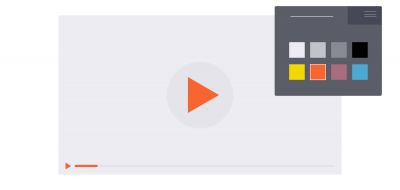Hundreds of successful media brands have gotten their start in online video by creating a channel on YouTube. All it takes (at least initially) is a sizable content library and enough of an investment to keep making or acquiring great video content.
Once your YouTube channel has found its audience and you continue to fuel it with high-quality video, your business can open up plenty of options to monetize content. The most successful media brands on YouTube already employ a variety of them:
- Advertising
- Sponsorships
- Merchandising
- Licensing
- Donations
- Crowdfunding
Making the most of these monetization strategies depends on the quality of your content. But it also depends on the size of your marketing budget to tap into YouTube’s built-in audience of 2.6 billion monthly users.
YouTube may be the world’s largest video-sharing platform, but its shiny promise of monetization is not without pitfalls. Ultimately, the success of your content (and therefore your business) is dependent not only on someone else’s platform, but on someone else’s audience.
Monetizing content on YouTube means standing out against the other 2 million Partner Program members actively competing for ad dollars. That’s 2 million reasons why you should start thinking beyond YouTube. When you realize your media business can stand on its own, you only need five reasons to consider advancing to your own branded video streaming platform.
1) RENTED AUDIENCES
For years, businesses have built their audiences through content hosted on major platforms like Facebook, Instagram, Twitter, or YouTube. On the plus side, they’re all flush with millions (or billions) of people already using the platform. You might have tens of thousands of them subscribed to your own channel.
However, the subscribers to your YouTube channel aren’t yours, they’re YouTube’s. Their accounts are beholden to YouTube’s terms of service, not yours. The way you organize your subscribership fits YouTube’s business model, not yours. Even the available analytics are subservient to YouTube’s discretion, not yours.
So long as your audience exists on another platform, you’re merely “renting” that audience. Which means if that platform is prohibited in certain viewing situations (schools, institutions, countries), your content isn’t reaching its full audience potential.
2) FREE-FOR-ALL MARKETING
Famously, the major social platforms have been forever free, easy to use, and filled with advertising opportunities. Each has clever search functions designed to serve up your content to the right people typing the right terms.
But then came the algorithm changes. And with each iteration came a little bit less certainty over when or even whether the target audience would find your clip or promo. On top of that, the same algorithms would note your target audience’s habits and feed them your competitors’ content as well.
A free platform is exactly that: a platform where everyone is free to distract each other’s audiences and dilute their marketing tactics.
3) CONTENT MODERATION
There are two words that can strike fear in any popular independent media business: content moderation.
Between AI errors, fallible human reviewers, and non-target audiences wandering onto the wrong channels, content gets flagged for removal that doesn’t necessarily spark controversy. Similarly, it’s possible for a guest in an otherwise mild programming lineup to make a remark that would get bleeped in prime time. But if it violates platform policy, it gets removed.
If you want to retain the freedom of (and responsibility for) your own content, you can’t do it on someone else’s platform. You need a monetized video platform whose viewers belong to the target audience and signed up to be there, rather than stumbling upon it by accident.
4) LIMITED DIVERSIFICATION
YouTube offers several ways to capture revenue, and many individuals, personalities, and celebrities have found incredible success this way.
But like any of those free video monetization platforms or video platforms that pay, diversification options are limited. Once your business model can sustainably grow your content library and audience, scaling to the next level requires multiple monetization models.
For example, serious media companies are finding that they can supplement advertising video-on-demand (AVOD) with subscriptions (SVOD). However, they’re using their own subscription platform because they can’t monetize the subscribers they “rent” on a free platform.
Some companies are also offering occasional one-off events, such as pay-per-view (PPV) live streams or downloadable, transaction-based premium content (TVOD). These tactics keep subscribers engaged and satiated through exclusive, fresh content.
Becoming a recognized video brand with thousands of hours of your own (or licensed) video is the YouTube dream (and it often comes true). But your business cannot truly capture the value, preferences, and habits of the audience you’ve built until you operate your own video streaming channel.
5) BUDGET EXPERIENCE
Creating content within YouTube’s AVOD economy is as simple as uploading your videos. Getting your audience to pay for that content, however, is when a free platform can only give what you pay for.
Premium content requires a viewing experience that “feels” premium—something enjoyable, of high quality, and in an environment that matches the way the content is being consumed. Try creating that experience with a private YouTube link and you’ll find it simply doesn’t communicate value to the viewer. Not to mention leaving them vulnerable to your competitors’ content.
A secure video platform with your branding doesn’t just protect your content and elevate the viewing experience. It architects the ideal environment for your business to cultivate customer loyalty over the long term. Whether through your existing website, an elegant gallery page, or an OTT app, there are several ways a world-class platform can give your viewers the experience they want.
MONETIZING CONTENT ON YOUR OWN PLATFORM
No one can argue with YouTube’s role in today’s creator economy. However, it’s still a channel, not a platform. And its built-in audience belongs solely to YouTube. It sets the rules to market, moderate, and monetize content within an environment it controls.
Growing your business means growing your audience, not someone else’s. Whether that’s through SVOD, PPV, TVOD, or taking the leap into live linear programming, you need complete control over your audience and your content. You need control over your video branding and experience. You need your own platform, not another channel.




